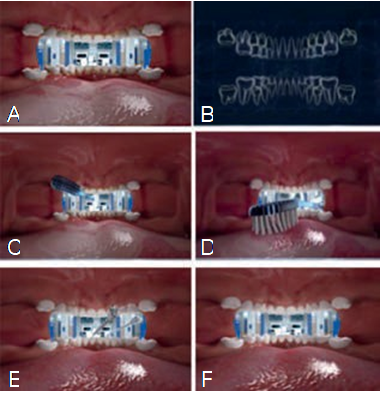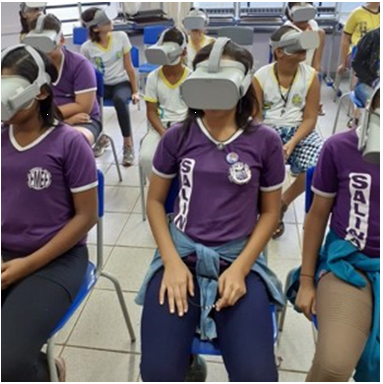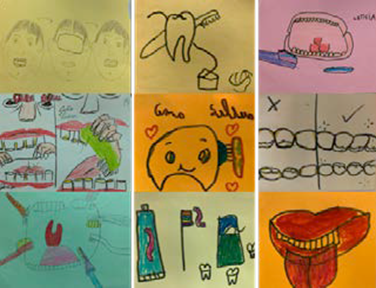Intoduction
With population growth, oral health issues are increasingly important to society. Oral diseases are still an important public health problem. According to WHO (World Health Organization) statistics, more than 60% of children worldwide have dental caries (1).
Advances in technology influence different areas of society (2) and can be applied in different areas, such as health care (3). Standing out in health focused technologies, virtual reality (VR) immerses users in a three-dimensional, interactive, computer-generated environment that simulates the characteristics of the real world, spaces and imaginary objects (3,4,5,6,7). It originated in the 20th century with great advances in the 1980s (3).
This technology provides a subjective experience of being in one place or environment, even when physically located elsewhere. Another effect is immersion, in which sensory and perceptual information can offer a therapeutic environment (7).
VR is used as a professional learning tool (2) where educational programs based on VR technology can provide pupils with instant and consistent feedback (8). There is growing interest and evidence for the benefit of using interactive computer-based technologies to transform education and increase the autonomy and quality of life of individuals with VR (9).
Through VR, it is possible to create a learning environment which allows participants to practice social skills in a non-threatening, synthetic, but realistic, motivating, controllable and diversifiable environment during learning (10). There is evidence that VR technologies can, and do represent authentic and plausible social settings and scenarios, reflecting and supporting real-world conventions, understanding and behaviors for a variety of different user groups (8,11).
VR has been used in neuropsychological assessment to diagnose and treat various mental illnesses. Therapy through VR permits the use of a realistic and involving environment, adapted to the needs of the individual and allows repetitive, consistent and systematic training. The capabilities of VR make it useful for patients with mental health problems. In the field of pediatric psychiatry, VR is used for attention training, social skills, cognitive rehabilitation and education. Previous studies have shown that children displayed more interest in participating in training through VR; one explanation being that in children and adolescents, neurological development makes the VR environment appear more vivid than in adults. Therefore, the VR experience can have a stronger impact on children and adolescents (12,13).
Dentistry is one of areas where VR applications can be used in various oral health related topics. Childhood, especially the first years of school life, is a time of discovering sensations (14); it is also when dental eruption of the first permanent teeth occurs (15), making it a propitious time for oral hygiene focused learning.
The benefits of using VR to reduce dental anxiety and pain levels during dental procedures have been widely addressed in scientific literature (16,17,18,19,20,21), and its usefulness as a distraction tool is receiving increasing attention in medical settings (20). During aversive experiences, VR can improve pain management and reduce the perceived duration of a procedure (21). Some studies have shown that, for both pain and anxiety, the use of VR is more effective in children than adults. One possible reason for this may be that VR is especially attractive to children as they become more involved in capricious thoughts and are fascinated by imaginative play (19,20,21).
Health education programs in the school environment which focus on healthy habits and behavior, are able to improve the level of knowledge children have in relation to the health-disease process, and are thus considered an effective option. In addition, children in a certain age group and who have contact with the construction of healthy habits, can perpetuate such habits during adulthood.
Using VR, we can create simulators that allow the improvement of skills, such as simulating virtual patients with certain clinical conditions, so that the user can train on interventions, and observe the effects and reactions in the virtual organism (5).
Although studies show positive results with VR, there is little evidence related to oral health, especially with a focus on prevention. Thus, the objective of this study was to evaluate the effectiveness of virtual reality in oral hygiene education. The study is based on assessing whether VR will be able to change the habits of participants. Our hypothesis is that VR will be effective in improving oral health habits.
Materials and methods
This study was approved by the by the Ethics Committee of São Paulo State University (UNESP), School of Dentistry, Araraquara (CAEE: 24730219.9.0000.5416). Children aged 9 to 12 years, pupils from public schools in the city of Araraquara, São Paulo, Brazil were invited to participate in the study. To participate in the study, free and informed written consent was obtained prior to intervention from guardians. Participants were informed about their free choice of whether or not to participate in the study. In the first stage of the study, 350 pupils took part, but 50 of these did not participate in the second stage. Thus, a final sample size of 300 participants was used in the statistical analysis.
We employed systematic probabilistic sampling. For inclusion criteria, participants were defined as being 9 to 12 years old without any psychological handicap. For exclusion criteria, participants were defined as those who refused to participate in the study, those who were younger or older, and those with some psychological disability.
This project was undertaken in partnership with the Social Service of Commerce of Araraquara City (SESC Araraquara). SESC Araraquara developed the project “Inside the Mouth”, which consisted of visiting some public schools in the city and using VR glasses to show themes related to oral health.
Oral hygiene questionnaires were applied before and after (one week apart) using VR glasses, where oral hygiene instructions were demonstrated (Figure 1 and Figure 2). The questionnaires were pre-tested by means of a pilot evaluation, in order to establish consistency and effectiveness. Forty virtual reality glasses (Oculus Go, Facebook Technologies, Auburn, USA) were purchased by SESC Araraquara and used in the study. Participants were encouraged to write or make drawings related to the activity. After an interval of one week, the participants answered the oral hygiene questionnaire again.

Figure 2 A) Representation of the structures of the oral cavity and dental biofilm. B) Representation of mixed dentures. C) Representation of the toothbrushing movement. D) Representation of tongue brushing. E) Representation of the use of dental floss. F) Representation of a healthy mouth, with a clean tongue and teeth, after oral hygiene.
VR glasses allowed the development of a three-dimensional virtual environment of a mouth by a video lasting eight minutes in which issues related to oral hygiene are addressed in a playful way. In addition, this methodology is consistent with reality and is suitable for target audience understanding (children aged 9 to 12 years).
In this “Inside the Mouth” journey, participants visualized oral cavity structures, such as the tongue, teeth and cheek, and were able to observe curiosities and the care necessary for maintaining oral hygiene.
In the oral cavity, participants observed the dental biofilm, composed of bacteria, food debris and saliva, demonstrating that the dental biofilm is a dynamic structure, as bacteria are active organisms in the mouth. It showed that by using a toothbrush and dental floss, it is possible to remove or disorganize this biofilm, reducing the possibility of oral diseases appearing.
Pupils visualized the existence and difference between primary and permanent teeth. The focal point was the first permanent molar, showing that this tooth had just erupted, and being below the occlusal plane was subjected to greater plaque accumulation, thus stressing its importance for the life of the individual.
The virtual animation also presented brushing movement, using a toothbrush with properly positioned bristles, effectively removing the dental biofilm; and tongue brushing was also introduced. The correct use of dental floss was also demonstrated with correct positioning between the proximal surfaces of the teeth reinforcing its importance in removing food residues from areas that the toothbrush cannot reach.
A healthy mouth with a clean tongue and teeth was shown after oral hygiene, once again emphasizing the importance of oral health for a healthy body as a whole.
The journey ended with the appearance of an educational book, with stories, tips, and playful games. Those monitoring the session ended the educational activity by punctuating the main topics addressed by the dental games, and participants wrote or made drawings related to the activities.
Data were analyzed using the chi-squared and Fisher's exact tests with a significance level set at 5%.
Results
Table 1 presents the results of oral hygiene issues before and after the project activities. Issues such as proper oral hygiene, flossing and tongue brushing. The data are presented as percentages and total values.
There was no difference regarding oral hygiene knowledge before and after the Project activities (P=0.550, Fisher's exact test). However, after the VR project, a greater number of participants started to use dental floss (P<0.001, Chi-square test), and brush their tongue (P<0.001, Chi-square test).
Table 2 shows the daily toothbrushing frequency before and after participating in the project activities. The data are presented as percentages and total values.
An increase in daily toothbrushing frequency can be seen after participation in the VR project (P<0.001, Fisher's exact test).
Figure 3 shows some drawings made by participants after immersion in VR.
Two evaluators performed the descriptive evaluation, Kappa analysis was performed to measure the degree of interrater agreement on the results. The level of agreement was acceptable.
Analyzing the pupils drawings, we verified that 180 drawings were related to oral cavity structures, and depicted products used in oral hygiene, such as toothbrushes, toothpaste and dental floss; 30 drawings were related to VR glasses. Ninety messages were written by participants, most of them reported “I learned how to take care of my teeth”, “it was really cool”, “now I know how to brush my teeth”, “I learned how to use dental floss” and “I didn’t know I needed to clean my tongue”.
Table 1 Results of oral hygiene issues before and after the project activities.
| - | Before the activities | - | After the activities | - | Statistical analysis |
|---|---|---|---|---|---|
| - | Yes | No | Yes | No | - |
| Care related to oral hygiene | 256 (85.4%) | 44 (14.6%) | 295 (98.3%) | 5 (1.7%) | P=0.550 |
| Use of dental floss | 140 (46.6%) | 160 (53.4%) | 250 (83.4%) | 50 (16.6%) | P<0.001 |
| Tongue brushing | 236 (78.6%) | 64 (21.4%) | 290 (96.4%) | 10 (3.3%) | P<0.001 |
Table 2 Daily frequency of toothbrushing before and after project activities.
| - | None | Once | Twice | Three times | Four times | Statistical analysis |
|---|---|---|---|---|---|---|
| Before the activities | 5 (1.6%) | 44 (14.7%) | 128 (42.6%) | 110 (36.7%) | 13 (4.4%) | P<0.001 |
| After the activities | 0 | 4 (1.3%) | 57 (19%) | 158 (52.7%) | 81 (27%) | - |
Discussion
Due to the COVID-19 pandemic our study was only able to perform assessments in the week after the activity. Technically, our study would evaluate other periods such at one week, and one, three and six months, as well as clinically evaluate plaque score; unfortunately, we had to therefore adapt our study to the situation we are experiencing. Thus, we were only able to evaluate effectiveness based on oral hygiene measures reported by the pupils, which is a limitation of the study. Even so, we were able to observe from the questionnaires that participants increased the frequency of toothbrushing, flossing and tongue brushing.
VR has allowed an advance in the teaching- learning process, improving the population's quality of life (2,6,7). In recent decades, there has been a huge advance in technology aimed at VR (24) creating new immersive educational experiences, such as human anatomy (25) training in oral surgery (26,27) and even entertaining children during dental treatment (28). Modern 3D virtual systems have established the way for new approaches in medical imaging and education (6).
Pediatric dentistry also follows the high technology path, highlighting the importance of establishing habits aimed at oral hygiene. Oral education goes through recent developments and extraordinary research (29).
This present work is innovative, as no other studies were found analyzing the effectiveness of VR in oral hygiene instruction. It demonstrated an interactive, immersive, instructional and motivational environment in oral health using VR resources that allow effective interaction with the target audience.
This research reached children from low-income families who were pupils at public schools located in city suburbs. In many cases, parents do not have an education level to ensure adequate oral hygiene guidance, as there is a correlation between parent educational level and child oral hygiene (30).
Although there was no significant difference regarding oral hygiene care knowledge (Table 1), at the beginning of the study children reported having regular or good oral hygiene and, after motivation they reported good to excellent oral hygiene, according to brushing habits and dental flossing. Our results were similar to those of Markeviciute & Narbutaite (31) who when analyzing orphaned children after oral hygiene motivation, observed a significant improvement in tooth brushing frequency.
Most people require motivation in oral hygiene instruction to acquire the habit of regular tooth brushing and dental flossing (32,33). We observed an improvement in oral health care using VR motivation and instruction in young pupils.
Oral hygiene is extremely important for the prevention of oral diseases, especially caries and periodontal disease (34). Tooth brushing is one of the main habits that constitute oral hygiene. In this study, after receiving guidance and immersion in VR, most participants reported performing three brushings a day. Zotti et al. (30) when evaluating children who used technological applications to motivate oral hygiene also observed an improvement in oral hygiene, with a change in tooth brushing habits.
The results of our study corroborate with data found in literature, which show an improved adherence to oral hygiene performance in children when applying technological support (29,30,31,34). These digital tools are a good option for instigating behavioral change in oral hygiene, as they meet the needs while at the same time offer children motivation through fun (29).
As an educational method, VR allows the use of videos containing instructions related to oral hygiene; an additional advantage is that a video can be used repeatedly without any extra effort (35).
Above all, health promotion that seeks to address socioeconomic inequalities is extremely important since low-income children miss more school days due to dental diseases than children from high-income families (34).
At the beginning of the study, some children reported not having dental floss in their homes or not knowing how to use it. It is therefore necessary to provide instructions and support for the habitual use of dental floss, as only 10% of the population habitually use it, and it is indispensable for adequately cleaning the proximal surfaces when considering satisfactory oral hygiene (33).
Blake et al. (34) also found a significant increase in the level of dental floss use in children after oral health intervention, demonstrating that oral hygiene behavior changes after motivation.
They emphasized that promoting oral health can generate positive changes in knowledge and behaviors about oral hygiene in children.
The drawings and messages made by participants after participating in the VR project were all related to instructions in the video; most drawings presented oral cavity structures with the presence of dirt, and after brushing, sanitized structures (Figure 2) as well as the positive messages. We suggest that instruction by VR was considered fun as the children were committed and enthusiastic.
These instructed and analyzed hygiene habits are of great importance, as they are acquired in childhood by an educational and instructional process (33). Thus, the daily practice of oral hygiene is of paramount importance in educational programs which are aimed at preventing oral diseases.
This study presented an improvement of oral hygiene reports with the assistance of VR as a method of teaching good oral hygiene practices. One limitation of the study is the verification and quantification of bacterial biofilm before and after participation in the VR project. Future studies are needed to evaluate this variable.
Conclusion
The use of VR for oral hygiene instruction is effective and has a positive impact. It is an interactive, motivational and playful environment for oral health education. Most participants increased their brushing, flossing and tongue brushing frequency. VR presents innovative perspectives that can assist oral health education for young pupils.
Author contribution statement
Conceptualization: L.E.G. and T.S.O.C. Methodology: L.E.G.
Formal analysis: C.L.G.P. Investigation: J.V.M. he g.
Resources: D.H. and C.L.G.P.
Writing-preparation of the original draft: L.E.G. and D.H.
Writing-proofreading and editing: L.E.G. and C.L.G.P. Visualization: J.V.M., D.H. and T.S.O.C.
Supervision: T.S.O.C.

















